July 13, 2007
Air Date: July 13, 2007
FULL SHOW
SEGMENTS
Blue Jeans, Blue Water
/ Jana SchroederView the page for this story
In Mexico, the production of worn-out jeans has environmentalists singing the blues. Manufacturing methods send chemicals into nearby waterways. Jana Schroeder reports on how environmental authorities do and don’t enforce Mexican environmental laws. (10:00)
The Language of Landscape
/ John DanielView the page for this story
Living on Earth revisits its first installment of the series "Home Ground: Language for an American Landscape," based on the book of the same title edited by Barry Lopez and Debra Gwartney. In this first installment, Oregon writer John Daniel muses on the word “cascade.” (02:45)
Wetland Mystery
/ Ashley AhearnView the page for this story
Marsh grass is dying in wetlands in the northeastern U.S. Scientists are having a hard time finding out what’s causing this “sudden wetland dieback.” Living on Earth’s Ashley Ahearn visited some sick wetlands and has our story. (05:00)
Timothy the Turtle
View the page for this story
What does a turtle think when it looks at us humans? That's the question New York Times columnist Verlyn Klinkenborg sets out to answer in his new book: “Timothy; or Notes of an Abject Reptile.” (09:00)
Thai Traditions Gone By
/ Pim TechamuanvivitView the page for this story
Food blogger Pim Techamuanvivit remembers the natural food packaging of her childhood in Thailand. She laments that plastic, styrofoam and staples have increasingly taken the place of natural containers such as banana leaf and bamboo tubes. (03:30)
Emerging Science Note/Nanorust
/ Ian GrayView the page for this story
Scientists say rust, magnets and olive oil may be the solution to cleaning water with arsenic in developing nations. Ian Gray reports. (01:30)
Old Mill Gets Green Makeover
/ Bruce GellermanView the page for this story
An historic, but rundown, mill in Lawrence, Massachusetts is being transformed into the nation's largest green redevelopment project. The famous Wood Mill, once the largest textile mill in the world, will be converted into condominiums that use geothermal heat. Living on Earth’s Bruce Gellerman reports on the mill, and on Lawrence, past, present and future. (15:00)
This week's EarthEar selection
listen /
download
The calls of Arizona treefrogs, who are not afraid to make themselves known.
Show Credits and Funders
Show Transcript
HOST: Steve Curwood, Bruce Gellerman
GUESTS: Verlyn Klinkenborg,
COMMENTARY: John Daniel, Pim Techamuanvivit
Reporters: Jana Schroeder, Ashley Ahearn, and Bruce Gellerman
SCIENCE NOTE: Ian Gray
[THEME]
CURWOOD: From Public Radio International - this is Living on Earth.
[THEME]
CURWOOD: I’m Steve Curwood. Wetlands up and down the Northeast coast of the U.S. are in trouble with green, lush salt marshes turning into brown, barren flats of mud.
SMITH: I mean this amazes me, look at these plants just barely hanging on. There’s no soil left around the root mass, it’s just gone.
CURWOOD: Scientists search for clues to solve the wetland dieback mystery. Also, this week a landmark building from New England’s industrial revolution has lain fallow for years. Now it’s being redeveloped using clean and renewable geothermal energy.
ANSIN: We decided if we’re going to bring this building back, let’s bring it back in a way that minimizes the impact on the environment and let’s respond to the people who are coming here to buy condos.
CURWOOD: Bread, roses and geothermal energy, those stories and more on Living on Earth. Stick around!
[MUSIC: Boards of Canada “Zoetrope” from ‘In A Beautiful Place Out in the Country’ (Warp Records – 2000)]
[NPR NEWS CAST]
ANNOUNCER: Support for Living on Earth comes from the National Science Foundation and Stonyfield Farm.
[THEME]
Blue Jeans, Blue Water
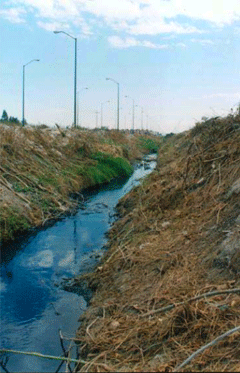
Chemicals from blue jean factories in Tehuacan, Mexico, have turned nearby canals bright blue. (Photo: Maquila Solidarity Network and the Human and Labour Rights Commission of the Tehuacan Valley)
CURWOOD: From the Jennifer and Ted Stanley Studios in Somerville, Massachusetts - this is an encore edition of Living on Earth. I’m Steve Curwood. Perhaps you’ve wondered how that new pair of jeans got that already lived-in look? They may have gotten that way at a factory in Mexico where the jeans are hand-rubbed with sandpaper, sprayed with color and bleaches, or even washed with rocks. It seems there’s a price for fashion: a lot of water and chemicals are used in the process. Jana Schroeder traveled to a place that was once the blue jean capital of the world and has our story.
SCHROEDER: In a valley in central Mexico is the city of Tehuacán. The name means, “place of the gods” in Nahuatl. The city used to be known for its pure spring water believed to have healing properties.
HERNANDEZ: Whenever you hear the word Tehuacán, you think of water because it has become famous all over the centuries because of the high quality of the mineral water that springs up in this area.
SCHROEDER: Raúl Hernández has been working on water conservation in the Tehuacán area for 25 years. He says the local water has been ideal for bottling, and a popular brand of mineral water is even named after the city.
HERNANDEZ: Whenever you go into any restaurant in Mexico, and you want mineral water, you don’t ask for mineral water, you just say ‘I want a Tehuacán.’
SCHROEDER: The water was also once used in a thriving soft drink industry that has since fizzled out. Now, some of the abandoned facilities – built right over natural springs – are used by another industry that needs easy access to large volumes of water—the blue jean industry.
HERNANDEZ: One of the important processes in the blue jeans manufacturing is the stonewashing to give this kind of worn look by adding chemicals for color and then stones for washing it away,
SCHROEDER: Mr. Hernandez, who directs a nonprofit called “Water Forever,” says much of the water that goes into blue jean factories comes out contaminated with bleaches, detergents, dyes and other chemicals.
[VOICE: “Vamanos,” DOOR SLAMS SHUT, JEEP DRIVES OFF]
SCHROEDER: The chief engineer for the group, Gerardo Reyes, drives us to a blue jeans laundry on the outskirts of the city.
MAN: Allí está la lavandería, y allí puedes ver el agua que está corriendo.
SCHROEDER: We stop along the road just short of what looks like a small warehouse. Next to the road runs a stream of bright blue water in a narrow canal. It’s coming from the plant.

(Credit: Maquila Solidarity Network and the Human and Labour Rights Commission of the Tehuacan Valley)
[JEEP DOOR OPENS AND SHUTS, WALKING. VOICE: “El agua está totalmente azul”]
SCHROEDER: The engineer says the noise we hear comes from the laundry machines. He points to the blue water with bits of pumice stone and lint, and says the water has obviously not been treated. He says this is worrisome since the aquifers—the underground water— are very close to the surface in this valley, and easily contaminated.
MAN: No va a ninguna planta.
SCHROEDER: Farther downstream, the canal becomes overgrown with weeds, so we can’t follow it to see where it goes, but a half mile from here is an old irrigation canal, the Valsequillo. This bigger canal was originally built to bring clean water from the hills above, but now it’s used to collect wastewater. Local environmental authorities are trying to crack down.
[OFFICE SOUND]
ATELA: Here we have the last inspection we have done in a laundry.
SCHROEDER: Martín Atela heads Tehuacán’s Environment Office, which has banned any new blue jean laundries within city limits. Since he took this post last year, he’s been inspecting those already operating.
ATELA: Sometimes if they do not want to open the door, is one of the problems, we have to be in the right place at the right moment. What we need is to have a permanent inspection, to see what is really happening there.
SCHROEDER: At one facility Mr. Atela found a treatment plant installed, but sitting idle. Critics of the industry say that’s not an isolated case, but Mr. Atela points to what he thinks is a bigger problem.
New blue jean factories, known as maquilas, are still coming in, but since the city tightened its standards, they’re locating in outlying areas, where there are no environment officials.
ATELA: Now every year more laundries are established because there are no regulations, local regulations.
SCHROEDER: Mr. Atela says a regional approach is needed—since his efforts are undone when contaminated water from the maquilas upstream flows down the Valsequillo Canal right through the city. But he says things are changing, thanks to foreign environmental standards.
ATELA: There are enterprises, especially foreign companies, that are asking us to make the inspection, because they need our official papers to testify that they are working well in order to export, and for us that’s wonderful.
SCHROEDER: Many smaller maquilas that sell within Mexico are immune from this foreign pressure. So, Mr. Atela says foreign companies are the best partners he’s found for reaching environmental goals.
Arturo Neira is the Export Manager at the largest blue jean maquila in the area, Cualquier Lavado. It churns out about ten million pairs of jeans a year for leading US brands such as Levi’s, GAP, and Old Navy.
NEIRA: Most of the prestigious brands that we work with request that we comply with all the environmental measures or laws obviously it has a cost. I know we made a huge investment, more or less about two million dollars.
SCHROEDER: Mr. Neira says the maquila sector is facing heavy criticism, for worker treatment and environment standards, just when it’s struggling to survive the tough competition.
NEIRA: Right now, this industry is, instead of growing, we’re going down. Because, we’re competing against the Orient, China, Central America, and they have labor costs which are a lot cheaper than us.
SCHROEDER: Mr. Neira takes me on a tour through the plant. He says the processes used are dictated by changing fashions. “Sand blasting” has been replaced by hand-sanding blue jeans with sand paper.
We walk by an area where workers—covered from head to foot with protective suits, masks and gloves—are spraying jeans with a bright purple chemical, potassium permanganate.
NEIRA: No es consejable respirarlo.
SCHROEDER: Mr. Neira says the chemical, which should not be inhaled, is one of those used to give jeans that “already worn” look. His company has installed an expensive water treatment plant, with a full-time engineer. But most plants are smaller and don’t invest in these controls.
Out behind the plant, Mr. Neira points to a small stream of clear water he says is the treated water from his factory. We watch it flow down into the Valsequillo Canal, where it immediately mixes with untreated wastewater from other maquilas, agricultural wastes, and sewage.
Where does all this wastewater end up? The same place it did back when clear water ran through the canal--into cornfields downstream.
[CORN FIELD SOUNDS]
SCHROEDER: Martín Barrios, the director of a human rights commission in Tehuacán, accompanies me about twelve miles down the valley, to the farming community of San Diego Chalma. Mr. Barrios is a labor activist and has co-authored a book about blue jean maquilas.
[WALKING IN A FIELD]
From the highway we walk a short distance into a cornfield fed by an irrigation ditch filled with dirty water.
BARRIOS: Ves esta milpa. Ayer o anteayer fue regada.
TRANSLATION: Look at this cornfield. You can see it was irrigated yesterday or the day before.
SCHROEDER: He picks up some of the soil. It has a bluish-gray layer on top that crumbles in his hand.
BARRIOS: Aquí es donde se termina finalmente su recorrido las aguas azules de las lavanderías…
TRANSLATION: This is where the blue water from the laundries reaches its final destination. Look at this handful of soil. It's all blue. Unfortunately, the negative side of globalization has brought this pollution from blue jeans to the fields and now it contaminates the food we eat in Tehuacán.
SCHROEDER: Local authorities concede that watering food crops with untreated industrial wastewater is a problem. Still, they say they haven’t tested the liquid to find out exactly what’s in it.
Mexico has environmental standards that limit the contaminants allowed in industrial discharge. Yet, ten years after the standards went into effect, authorities in Tehuacán say inspections are still only in the planning stage. A treatment plant at the end of the canal is also still on the drawing board.
BARRIOS: Dicen que ya va a venir la planta tratadora, tiene la planta tratadora, seis años...
TRANSLATION: They’ve been saying a treatment plant is coming for the last six years. Every year they say ‘next year.’ We need to demand that the treatment plant be built, and paid for not just by the town. These foreign plants have to pay for the problems they're creating. It’s everyone’s responsibility.
SCHROEDER: New blue jeans used to come off the shelf stiff and in a dark navy color. They took months to wear in. Some of today’s young consumers may not remember that. Activists like Martín Barrios wish more people would ask what it takes to give jeans that already-worn look and feel—the first time you slip them on.
For Living on Earth, I’m Jana Schroeder, in Tehuacán, Mexico.
[MUSIC: Daniel Lanois “O Marie” from ‘Arcadie’ (Daniellanois.com - 2005)]
Related link:
Maquila Solidarity Network
The Language of Landscape
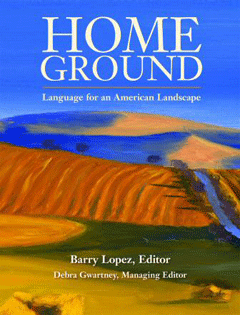
Home Ground: Language for an American Landscape, edited by Barry Lopez and Debra Gwartney. (Courtesy of Trinity University Press)
CURWOOD: Forty-five American writers are helping us get to know this place we call home a little bit better in a new book called “Home Ground: Language for an American Landscape.” It’s basically a dictionary of hundreds of unique and unusual features of the vast American countryside. We’ve invited some of the contributors to “Home Ground” to share definitions with us. And this week it’s Oregon writer John Daniel reading his definition of a signature feature of his part of the country: Cascade.

Home Ground: Language for an American Landscape, edited by Barry Lopez and Debra Gwartney. (Courtesy of Trinity University Press)
The cascades of the Columbia River formed several centuries ago when a massive slide filled a channel in the mid Columbia Gorge presented Louis and Clark’s core of discovery with a three miles stretch of chutes and falls boiling in a most horrible manner, according to William Clark’s journal.
Rafting or boating the gorge was the last leg of the Oregon Trail for many early immigrants. Some lost all they owned to the Cascades and some lost their lives. Now drowned in slack water behind Bonneville Dam this reach of river gave the Cascade Range its name.
CURWOOD: John Daniel lives and writes in the hills just outside of Eugene, Oregon. His definition of “Cascade” is in the book “Home Ground: Language for an American Landscape,” edited by Barry Lopez and Debra Gwartney.
[MUSIC: Don Williams “Till The Rivers All Run Dry” from ‘Don Williams: Anthology’ (UMG Recordings – 2000)]
Related links:
- Home Ground: Language for an American Landscape
- John Daniel's website
CURWOOD: Coming up: we visit the CSI of wetlands. That’s just ahead on Living on Earth.
[MUSIC: Beastie Boys “The Kangaroo Rat” from ‘The Mix-Up’ (Capitol Records - 2007)]
Wetland Mystery
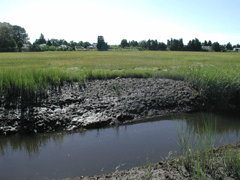
An area exhibiting dieback at the Hammonasset State Park wetland in Connecticut. (Photo: Wade Elmer)
CURWOOD: It’s Living on Earth. I’m Steve Curwood. Coastal wetlands help filter water and provide some of nature’s best protection from storms. But in parts of the Northeast coast of the U.S., something murky is going on in wetland salt marshes and scientists are perplexed. Once healthy green marsh grasses are now mottled with patches of brown stalks. Researchers call it Sudden Wetland Dieback and it’s happening from Maine to New York. Living on Earth’s Ashley Ahearn went to the wetlands to investigate.
[MARSH BIRDS/WATER GURGLING]
AHEARN: The Wellfleet Salt marsh on Cape Cod Massachusetts stretches for acres. Green grasses sway gently above dark brown muck, tapering off into blue ocean. From a distance, it’s a painter’s paradise, the picture of wetland health.
[FEET CRUNCHING ON MARSH GRASS]
AHEARN: But walk a hundred yards or so into the marsh, and the scene is a bit different.
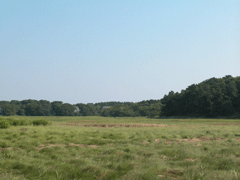
An area exhibiting dieback at the Hammonasset State Park wetland in Connecticut.(Photo: Wade Elmer)
AHEARN: Steve Smith is a plant ecologist for the Cape Cod National Seashore. He’s crouched down in the muck plucking at the dead stalks of what used to be green marsh grass.
SMITH: I mean this amazes me. Look at these plants just barely hanging on. There’s no soil left around their root mass. It’s just gone, all that is gone.

Steve Smith of the Cape Cod National Seashore surveys sick marsh. (Photo: Ashley Ahearn)
SMITH: That’s what’s perplexed us because this pattern of dieback does not correlate in any obvious way with the typical stressors on plant physiology and salt marsh plant vigor.
AHEARN: Stressors, like pollution, drought, flooding or ice damage, have been ruled out. But for every killer scientists cross off the list, another presents itself.
[HAMMONASSET MARSH – FOOTSTEPS IN MARSH]
AHEARN: In a wetland a state away, plant pathologist Wade Elmer of the Connecticut Agricultural Experiment Station, takes some samples of sick plants at Hammonasset State Park.
[SHOVEL IN MUCK, SLURPING AS SAMPLE COMES OUT]
ELMER: We’re the CSI of the plant world here.
[SHOVEL SOUND TO COVER LAUGHING]
AHEARN: Elmer specializes in a plant-eating family of fungus called Fusarium, which he thinks is causing lesions on the tips of the marshgrass.
ELMER: This is of interest to me because there’s a lot of death on there and if you look at how the sun shows through the leaf here you can see all the little lesions beginning to form there, and this is where I isolate a lot of Fusarium.
AHEARN: But this isn’t your day to day crop-devouring variety of the fungus. This is a brand new strain of Fusarium and Elmer’s got some good evidence that it might be part of what’s killing the Northeastern wetlands.
ELMER: What I find is that plants that are showing tip dieback, when I take them back to the lab and isolate them about 80% of the pieces that I put onto an auger plate will give rise to a Fusarium colony, suggesting that there’s a lot of Fusarium on this dying tip back.
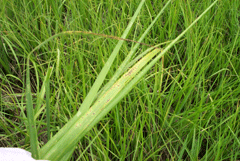
Wade Elmer suspects the fusarium fungus is eating away at marsh grass tips, causing the grass to turn yellow.(Photo: Wade Elmer)
AHEARN: Elmer’s colleague, Jim LaMondia, searches for clues in the marsh as well, but he’s working from the bottom up. In a metal pail, he rinses muck off a clod of marsh grass roots in search of nematodes.
LaMONDIA: A nematode is a plant parasitic round worm. They typically have stylettes that they stab the plant cells with and suck cell contents out and they cause the plants to be stunted and do poorly.
AHEARN: In the Hammonasset marsh, LaMondia has found a type of root-knot Nematode that only lives in wetlands. As he washes the mud away from the marsh grass sample, he looks for tiny white pustules, or galls, full of Nematode eggs.
LaMONDIA: There’s one right there! Ok what we have here is a sort of an egg shaped gall at the end of the root system which will have probably I’d guess maybe a dozen nematodes in it once we dissect this out under the microscope.
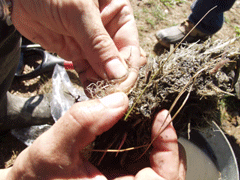
Jim La Mondia suspects nematodes are stunting growth of marsh grass roots. (Photo: Jim La Mondia)
LaMONDIA: Exactly, it’s a feeding site for them and they develop and produce hundreds of eggs each and it spreads from there.
AHEARN: LaMondia has found high concentrations of nematodes in these grasses. He suspects that the parasitic root-eating worms may be teaming up with Wade Elmer’s leaf-eating fungus, to kill the marsh grass from root to tip.
He and Elmer aren’t the only ones following up on their hunches. Another scientist in Rhode Island plans to study nocturnal crabs that might also see marsh grass as a tasty treat.
[MARSH SOUNDS]
Steve Smith, of the Cape Cod National Seashore, says scientists are just starting to piece together what little evidence they have to solve this intricate ecological puzzle.
SMITH: It’s this big complex web of interactions among environmental, physical, chemical, hydrological factors with biological and perhaps pathogenic factors that is difficult to untangle.
AHEARN: And with hurricane frequency and intensity predicted to increase in the Northeast, scientists here know there’s much to be lost if more isn’t learned about what’s causing sudden wetland dieback.
For Living on Earth, I’m Ashley Ahearn in Wellfleet, MA.
[MUSIC: Cinematic Orchestra “Familiar Ground” from ‘Ma Fleur’ (Nonesuch Records – 2006)]
Related links:
- New England Sudden Wetland Dieback Information Page
- Massachusetts Office of Coastal Zone Management
CURWOOD: You can hear our program anytime on our Web site, or get a download for your MP3 player. The address is loe.org, that’s l-o-e dot o-r-g. You can reach us at comments@loe.org, once again comments at l-o-e dot o-r-g. Our postal address is 20 Holland Street, Somerville, MA 02144. And you call our listener line anytime at 800-218-9988, that’s 800-218-99-88.
Timothy the Turtle
CURWOOD: Okay, so a turtle—which after all is one of the most unassuming of all species on Earth –may not on the face of it seem like inspiration for a compelling and poetic novel. But then again, the turtle we have in mind was very real. For 40 years, she resided in the garden of Gilbert White, the author of “The Natural History and Antiquities of Selborne.” White is considered to be one of England’s first ecologists. In his nature-writing classic, White observed the turtle and noted its comings and goings in meticulous and, yes, loving detail. And now the turtle’s observations of human behavior come out from under its shell in a book by New York Times editorial writer Verlyn Klinkenborg. It’s called: “Timothy; or, Notes of an Abject Reptile.” Verlyn, thanks so much for coming on the show, and tell me, just who exactly was Timothy?
KLINKENBORG: Well, Timothy was a tortoise that came from the Mediterranean coast of Turkey. No one knows quite how Timothy got to England. She--and, in fact, Timothy was a female-- turned up in the port city of Chichester in 1740, and was purchased for half a crown by Gilbert White’s uncle, Henry Snook. And she lived in the village of Ringmer with the Snooks for 40 years, in a bricked-up courtyard that was pretty muddy, pretty wet, pretty uncomfortable living, until Mrs. Snook died in 1780.
At which point Gilbert White, her nephew, inherited Timothy, and dug her up, carried her back to his home in Selborne, England, about 50 miles south of London. And she lived there until the spring of 1794, when she was, I believe, found dead in the spring. She just didn’t come out of hibernation. Gilbert White had died the previous June, 1793. And her shell was preserved by the family as a memento of a creature that had been very important to them, and was eventually given to The Natural History Museum in London, where you can see it today displayed in a wall case.
CURWOOD: Now, how did you come to make Timothy your central character?
KLINKENBORG: Well, I had been interested in Gilbert White for a long time. He had written a book called “The Natural History of Selborne,” and I was reading through his journals one winter and just noticing how much attention he paid to Timothy. He weighed her, he watched her diet, he watched her hibernate, watched her come out of hibernation. And it just occurred to me that it would be fun to write a book in which the tortoise watched the natural historian. And it was one of those ideas that seemed complete in itself; I wrote down in my notebook “Do this.” And the next day I was off.
CURWOOD: Verlyn, I wonder if you could read this passage where Timothy the turtle describes how comical looking she finds us to be.
KLINKENBORG: Happy to do so.
[READING] For a time I flinched whenever a human approached, especially Mr. Henry Snook, who carried such a stoop of belly before him. The feet would stop, but the top might timber on to me. I still doubt the stability of the species. All that brain bulk merely to prop them up? Or are they less top-heavy than they appear?
CURWOOD: (Laughs) Oh, my. What made you think of this perception? I mean, what’s the vision that came to your mind, Ah, that’s how the turtle sees us!
KLINKENBORG: Really just imagination. Really just trying to understand what it would mean, for example, to be that low to the ground. One of the real things I noticed that was most helpful to me is I thought about how many postures does Timothy really have? Well, you think about it, there’s up, and down, in, and out; and that’s basically it. But you think about a human, and how flexible and mobile and adaptable – able to scratch anywhere, able to stand from one leg and hang from your knees from a tree bough. All of these things must’ve seemed so strange to a creature that had just a simple choice of postures.
CURWOOD: Is this a work of philosophy or a novel? Or are you going to tell me what Albert Camus said, that if you want to be a philosopher write novels?
KLINKENBORG: That’s probably a good answer. But what I would say is it’s whatever any individual reader brings to it. For me, it sounds a little odd to put it this way, but it was an act of scholarship because it meant four years of devotion to trying to understand, in as much detail as I could, the rhythm and the character, the nature, of not just Timothy’s life, but the life of the garden she lived in. The life of the parish she lived in. The life of the world she lived in.
CURWOOD: One of, perhaps, your philosophical points might be, if I may, that the things that animals do perhaps make much more sense than some of things that we humans do. There’s a passage I’d like you to read. You start with the words “How the naturalist begins to understand.”
KLINKENBORG: [READING] How the naturalist begins to understand after years of study. He records the when, and where, and which, of the birds of passage and beasts of the field. Those are the very questions that system is poised to answer. But why will never by solved by system. No number of small corpses dissected, tagged, and preserved will ever begin to answer why. How the nightingale sings, pitch of the notes, melody of the song, structure of the voice box. But never fully the nightingale’s why.
Woodmen tell me, Mr. Gilbert White notes, that fern owls love to sit upon the logs of an evening. But what their motive is does not appear. Is not the love of sitting upon logs of an evening motive enough? What is the motive for taking tea at the hermitage on a blue afternoon, gray and still? To understand the motives of the rest of creation, Mr. Gilbert White will have to consult his own. But humans are blinded, even the naturalist, by being human. Barely able to witness what is not human.
Mr. Gilbert White rides over the commons from Newton, late May in the human year 1784, reins his Galloway mare at the crest of the hanger. Every manner of living thing in sight or in memory on this sweet, warm evening. Bees thriving, flycatcher nesting under the parlor window, rooks at their endless beach-top quarrels, swallows taking food up and down the river feeding their young in exact rotation. Mare beneath him feeling the pull of home. Tortoise making her escape into the fields among the grass.
Brute beasts that have no understanding, says the prayer book, driven only by love and hunger. Driven, they know not why.
CURWOOD: Verlyn, there’s this lovely passage you’ve written where Timothy is deciding whether or not she can speak to Gilbert White, a man who in some senses really sees nature and loves it much more than many of the people around him. And Timothy gets to wondering how Mr. White would react if she, Timothy, looked at him and said, simply, “Now then.” Verlyn, is your book your way of giving Timothy permission to say, “Now then?”
KLINKENBORG: Exactly. Exactly. She says that she hides her words in her skull, behind her obsidian eye. She calls it the stern prow of her skull. And the point of language for Timothy is that language is how often humans…it’s the tool humans use to separate themselves from nature. They say, simply, well, we talk, and nothing else on god’s Earth talks. Therefore we are unique, we’re special, we have a special relationship to the Creation itself, whether you frame that in a Christian context or any other way.
And Timothy’s point is that to a certain extent every creature, every species, has its language, has its way of communicating, has its way of relating through meaning to the world around it. And that to say simply to Gilbert White, “Now then,” would be to destroy his sense of isolation, to destroy his sense of privilege, the uniqueness of his place in life. Which is something we humans take absolutely for granted, and which enables us to be such a destructive, rapacious, environmentally overwhelming species.
CURWOOD: One last question before you go.
KLINKENBORG: Sure.
CURWOOD: If you were to actually sound like Timothy, take on her accent, what would she sound like?
KLINKENBORG: Well, I’m going to leave that question to Dame Judi Dench, okay?
CURWOOD: (Laughs) Is she making the movie of Timothy?
KLINKENBORG: I think she would have the perfect voice.
CURWOOD: Verlyn Klinkenborg writes the “Rural Life” column for The New York Times. His new book is called “Timothy: Or, Notes of an Abject Reptile.” Thanks so much, Verlyn.
KLINKENBORG: Thank you very much, Steve.
[MUSIC: Anonymous Jazz Bass Bumper Music]
Related link:
“Timothy, or, Notes of an Abject Reptile” by Verlyn Klinkenborg
Thai Traditions Gone By

Banana leaf packaging. (Photo: Pim Techamuanvivit)
CURWOOD: On the streets of Bangkok, Thailand food is on almost every corner. Pim Techamuanvivit grew up in the city eating the delectable treats. Pim now lives in California, but when she returns to Bangkok for a visit, she sees changes in the way the food is being presented.

Kanom krok more often comes in boxes these days rather than in banana leaves. (Photo: Pim Techamuanvivit)

Spatchcocked chicken. (Photo: Pim Techamuanvivit)
There used to be charcoal-grilled chickens sold at practically every street corner. Each chicken is spatchcocked--the backbone is removed and the chicken is flattened. It's then kept in place with a tricky maneuver of splitting a thick stick of bamboo into two layers of connected prongs. The chicken is slipped in between the layers, with the strong bamboo prongs securing the chicken in place. When you buy one, you can take home the entire chicken-on-a-stick, no extra bag needed.

Khao lahm is now covered with plastic rather than a thin membrane from inside the bamboo tubes. (Photo: Pim Techamuanvivit)

Banana leaf packaging. (Photo: Pim Techamuanvivit)
Another old favorite of mine is Kanom Jaak, made of the meat of the Jaak palm mixed with coconut milk and flour, then wrapped in the leafs of the Jaak palm itself and secured with little sharpened sticks. Kanom Jaak is cooked on the grill, with the elongated Jaak leaf not only giving a unique aroma, but also making it easy to hold on to the ends while turning the package over the fire.
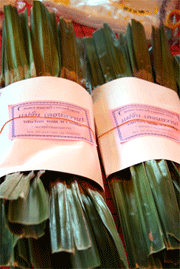
Kanom jaak (Photo: Pim Techamuanvivit)
It's only a matter of time, I suppose, before these beautiful traditions disappear completely. Meanwhile, I am savoring every one that I come across. I'm never sure if it will be the last time I'll ever see it.
CURWOOD: Pim Techamuanvivit writes a food blog called “Chez Pim.” To see photos of some of the delicacies she mentioned, go to our website, Living on Earth dot org.
[MUSIC: Architecture in Helsinki “One Heavy February” from ‘Fingers Crossed’ (Bar None – 2004)
Related link:
Pim’s food blog “Chez Pim”
CURWOOD: Coming up: what do you get when you mix rust, magnets and olive oil? Find out in just a few moments, right here on Living on Earth.
ANNOUNCER: Support for the environmental health desk at Living on Earth comes from The Cedar Tree Foundation. Support also comes from the Richard and Rhoda Goldman Fund for coverage of population and the environment. This is Living on Earth on PRI, Public Radio International.
[MUSIC: Player Piano “Down By The Old Mill Stream” from ‘Player Piano – All Time Favorites’ (Tandem Music Group - 1992)]
Emerging Science Note/Nanorust

Nanoparticles of rust bind with arsenic in water. (Courtesy of Rice University Office of Media Relations and Information)
CURWOOD: It’s Living on Earth. I’m Steve Curwood. Coming up: a giant mill complex from the industrial revolution is being reclaimed for today’s new green revolution. First this Note on Emerging Science from Ian Gray.
GRAY: Mmmm, a big glass of water, fresh, clean…exactly the kind of water that most people in the world don't have.
But, a team of scientists at Rice University is developing a low-tech filter that could help remove at least one unwanted contaminant from drinking water. The prime ingredients? — iron rust, magnets and olive oil.
The widespread contaminant is arsenic, a natural metal in rocks and sediments that can leech into ground water. Conventional ways of getting rid of arsenic are expensive, but the scientists from Rice say they’ve found a way to do it for cheap.

Nanoparticles of rust bind with arsenic in water. (Courtesy of Rice University Office of Media Relations and Information)
Since the nano particles are inexpensive to produce, the technology could be a boon for developing countries where arsenic is a big problem—countries like Bangladesh and Vietnam. The scientists hope they’ll be able to simplify the manufacturing process so that people in these countries can produce the nano-particles themselves. People could then use a low-tech filter and magnet to remove arsenic straight from their well water.
I’ll drink to that.
That this week’s note on Emerging Science, I’m Ian Gray.
Related links:
- “Nanorust Cleans Arsenic From Drinking Water”
- The United States Geological Survey’s fact sheet on “Arsenic in Ground-Water Resources of the United States”
- The World Health Organization on “Arsenic in Drinking Water”
Old Mill Gets Green Makeover
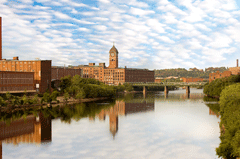
Lawrence, MA. (Photo: Massinnovation)
[MUSIC: WEST SIDE STORY: Debbie Gravitte “America (from ‘West Side Story’)” from ‘The Only Broadway CD You’ll Ever Need’ (BMG – 1995)]
CURWOOD: West Side story is a musical vision of immigrant America played out in New York City. But the vision was born, as was its composer, Leonard Bernstein just north of Boston in Lawrence, Massachusetts. Lawrence was the first stop on the way to the American dream for thousands of immigrants to the U.S., including Bernstein’s parents. The family was drawn from Russia by the boom created by the big textile mills of the first planned industrial city in America built on the banks of the Merrimack River. By the late 20th century, though the dream had died. The mills were mostly shuttered and Lawrence had become one of the poorest cities in the nation. But as Living on Earth’s Bruce Gellerman reports this relic of the industrial revolution is now trying to remake itself for a new century using green technology.
GELLERMAN: This is a tale of 3 cities: Lawrence, Massachusetts past, present, and future. You can see all three from the rooftop vantage point of an old mill building.
ANSIN: This is the challenging part of the tour.
GELLERMAN: Real estate developer Bob Ansin leads the way up a nearly vertical wood ladder to the top of the six story mill.
ANSIN: But I promise you it’s well worth the climb. And your reward.
[DOOR UNLOCKS]
ANSIN: My gosh, look at this.

Lawrence, MA. (Photo: Massinnovation)
A bald eagle soars overhead and a falcon swoops along the banks of the Merrimack River as it flows through Lawrence, East to the Atlantic.
ANSIN: They say in real estate, the three most important things are location, location, location. Show me a better location. I’ll tell you there aren’t any
GELLERMAN: The mighty Merrimack River is why the city’s founders chose this spot. They came to Lawrence to create an urban industrial city based on the latest technology.
The Great Stone Dam, constructed in 1847, harnessed the Merrimack - at the time it was the longest dam in the world. The water provided the energy to run more than 20 massive textile mills that rose along the river banks.
[CLOCK TOWER SOUNDS]
GELLERMAN: The clock tower atop Ayer Mill is still the largest of its kind in America, and right next door is the Wood Mill. When it was built in 1906 the huge red brick building was nicknamed: “the eighth wonder of the world” it was the largest textile plant on the planet. Four years ago developer Bob Ansin bought the old Wood Mill and renamed it: Monarch on the Merrimack.
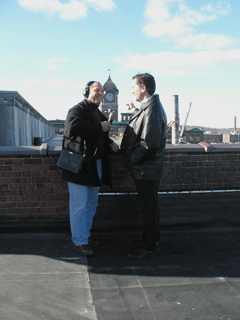
Bruce Gellerman interviews Bob Ansin as they look out at the old clocktower. (Photo: Bruce Gellerman)
GELLERMAN: The old mill is 1600 feet long and contains one and a third million square feet. But except for some warehousing the place has been empty for years. The mill is run down. So is Lawrence. The unemployment rate is twice as high, and incomes, half the state average. The old Wood mill is a metaphor for the city.
ANSIN: When I started this business people would tell me, “What do you want with an obsolete white elephant in a city like Lawrence?” And my response is, the only thing obsolete is thinking the fact that we economically can’t make textiles here eliminates one use out of a million uses for a building such as this.
GELLERMAN: Ansin is turning the white elephant into a huge green energy project; morphing the mothballed Wood Mill into Monarch on the Merrimack. There’ll be 600 luxury condos, a jazz club, a restaurant - café, and retail shops. Around the construction site are signs that read: “Green People Wanted”
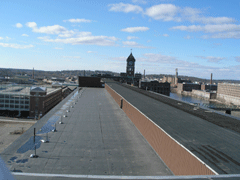
When the Wood Mill was built in 1906, it was hailed as 'the eighth wonder of the world.' At a third of a mile long and with almost 30 acres under one roof, it has been described as a horizontal skyscraper. (Photo: Bruce Gellerman)
GELLERMAN: To fulfill that vision and make it commercially viable to heat and cool the enormous mill building all factors pointed in one direction: straight down.
[DRILLING SOUNDS]
GELLERMAN: In the parking lot between the Merrimac River and the old Mill building workers drill into the earth.
BOVENZI: This right now, I believe is the largest, privately funded geothermal project in the United States.
GELLERMAN: Mathew Bovenzi is president of Commonwealth National Drilling, he and his workers are boring the first of 60 wells each 15 hundred feet deep into the granite below.
According to federal officials, a geothermal exchange system- like this one-is the most efficient and environmentally friendly way to heat and cool a building. Matt Bovenzi says it’s the best way on earth because it uses the earth. If you have ever walked into a cool basement on a hot day you know how geothermal exchange works.
BOVENZI: Essentially if you think of the ground as, the thermal mass is so large, it relatively stays at a constant temperature. At about five feet down, down to about 1500 feet you can expect the ground temperature to be 53-54 degrees Fahrenheit. So the idea is that if you take the heat load or the cooling load of the building and pump that into the ground, the ground’s temperature is going to stay constant so you can regulate the temperature of the building just by the temperature of the ground.
GELLERMAN: So what you do is, let’s say in the summer, you have hot water that comes out of the building, and it goes into the ground it comes out much cooler?
BOVENZI: Exactly. Essentially if the building is 80 degrees and you know the ground is 54, over time you just keep pumping the 80 degree temperature into the ground and then you bring the net difference of the cooling effect back into the building which will drop the building’s temperature.
GELLERMAN: And in the winter you reverse the process?
BOVENZI: Exactly
GELLERMAN: Monarch on the Merrimack’s geothermal exchange system is expected to save condo owners about 30 percent on their heating and cooling costs. The only fossil fuels used are to run the pumps and compressors. Bob Ansin says you’d have to plant a forest with 600 acres of trees to derive the same benefit to the environment as the Monarch on the Merrimack project will save in terms of global warming gases.

The ecoluxury lofts at Monarch were designed with sustainable development principles in mind - renewable resources (bamboo countertops, geothermal heating and cooling), reclaimed materials (reclaimed maple floors), and by hiring and purchasing locally, wherever possible.(Photo: Massinnovation)
ANSIN: Which will have trees and have plants and have grasses specially built to hold water as much as possible.
GELLERMAN: That will help prevent sewers on the ground from overflowing into the Merrimack River and keep the building cooler. But Ansin’s project isn’t just about protecting the environment for the future; it’s also about preserving the past. The mill building may be empty today but it’s filled with history.
JAYSANE: The wood mill was, for it’s time a very modern place.
GELLERMAN: Patricia Jaysane is executive director of the Lawrence History Center. She says the city lies at a critical junction in American industrial, cultural and technological history. It’s where the American labor movement was born.
[MUSIC: Bill Martin “The River Turns The Wheel” from ‘The River Turns The Wheel’ (Mill Rat Music – 1997)]
GELLERMAN: By the turn of the 20th century mill owners, who had started as urban idealists, had become cold-hearted industrialists.
Hundreds of thousands of workers came from Ireland and Italy, Eastern Europe and the Middle East to work the mills. Lawrence became known as Immigrant City a place of squalid tenements and horrendous factories.
JAYSANE: With all the mills you had the same kind of conditions. You had the machinery, which was incredibly loud.
[SOUND MILL WORKING]
GELLERMAN: Construction workers converting Wood Mill into Monarch on the Merrimack recently found these old recordings of mill workers and weaving machines.
WOMAN: The machine would start up and it might have a humming noise, hmmmmm. It wasn’t like the weaving room pickapickapicka oh my God.
[SOUND OF SEWING MACHINES]
GELLERMAN: 25 thousand people worked in the mills, most were women, many were children, some as young as seven years old.
JAYSANE: It was very dangerous work. Injury was very, very common as well as illness from the working conditions. The dust would just build up
GELLERMAN: A third of the workers died before they were 25. In the winter of 1912 a new Massachusetts law went into effect cutting the work week from 56 to 54 hours. Mill owners responded by speeding up the looms. The workers - 20 thousand strong - went on strike.
[MUSIC: I’M STICKING WITH THE UNION: Woody Guthrie (Composer) “I’m Sticking With The Union (Instrumental)” performed by unknown artist from ‘Lawrence, Mass. Music Library Archives’ (Source material reel-to-reel 1/4” tape – approx. 1941)]
GELLERMAN: The Lawrence Mill owners struck back with goon squads beating up workers. The National Guard was called in. For three months the workers held fast demanding bread, increased wages, and roses: respect.
[MUSIC: Judy Collins “Bread And Roses” from ‘Forever: The Judy Collins Anthology’ (Elektra/Asylum – 1970)]
GELLERMAN: The Bread and Roses strike was a turning point in the American labor movement and the Wood Mill was at its epicenter. Developer Bob Ansin:
ANSIN: 90 odd years ago had we been in this spot, in this mill, on this floor you would be seeing workers sabotaging their machines, you’d be seeing people from 50 countries, speaking 50 languages, marching along this hall way, convincing their fellow workers to also join the strike, as well they did.
GELLERMAN: In the end the mill owners met the workers’ demands.
[BELLS FROM AYER MILL CLOCK TOWER]
GELLERMAN: But at the end of World War Two textile manufacturers pulled the plug on Lawrence’s mills moving machinery and jobs to the south, then overseas, draining the lifeblood out of the city.
For a while main frame computers were manufactured in Wood mill. Then that technology became obsolete too and companies again left Lawrence. Unemployment soared. In the 1990’s the city became known as the arson capitol of the country. Lawrence was dying.
That’s the situation developer Bob Ansin found when he arrived with his plan to turn historic Wood Mill into Monarch on the Merrimack, mindful of the past but with one eye on the future and the other on the bottom line.

Bob Ansin, president of Massinnovation and developer of Monarch on the Merrimack. (Photo: Bruce Gellerman)
ANSIN: I didn’t become a green developer through being an environmentalist. It’s less risky and more profitable to use green technologies. I see this as smart business.
GELLERMAN: It’s a double green bottom line, part of a growing trend says housing consultant Ed Connelly.
CONNELLY: What I see, is I think the financing side is starting to drive it.
GELLERMAN: Connelly is president of New Ecology. His firm helps developers design and build green affordable housing projects. He says in recent years there’s been a fundamental shift among large financial companies interested in backing geothermal and other renewable energy projects.
CONNELLY: So it’s a very big change. I’ve been doing this for 10-15 years and 15 years ago, if you talked to corporate about this and they looked at you as a crazy tree hugger. And now that’s changing.
GELLERMAN: Connelly says, Monarch on the Merrimack is such a big geothermal project that if it’s successful it’s bound to have a huge economic impact on Lawrence, Massachusetts and serve as a model for other project. Still that’s a big “if”.
CONNELLY: In real estate market, I mean, obviously it’s still very complex. Location, location, location is still the mantra, that people are not going to go out of the way to buy a green building. At least most people won’t, but I think that in an increasingly competitive marketplace, that this is going to be one of the distinguishing characteristics of buildings.
GELLERMAN: That’s what developer Bob Ansin is banking on. His Monarch on the Merrimack project is a 200 million dollar bet that by restoring one old mill building in Lawrence using green technology he can help revitalize a city where hopes and fortunes once soared.
[MUSIC: Bill Martin “The River Turns The Wheel” from ‘The River Turns the Wheel’ (Mill Rat Music – 1997)]
ANSIN: We came to Lawrence with a vision for how to bring a place that was built for one economic reality, how to bring it back for today’s economic reality and do it in a way so that my kids and their kid’s kids will never find themselves in a position to have to say, gee too bad it wasn’t built sustainably.

Monarch on the Merrimac, Lawrence, MA. (Photo: Massinnovation)
For Living on Earth I’m Bruce Gellerman
[MUSIC Bill Martin “The River Turns The Wheel” from ‘The River Turns the Wheel’ (Mill Rat Music – 1997)]
Related links:
- MassInnovation
- New Ecology Inc.
- Lawrence History Center
- U.S. Department of Energy: Geothermal Technologies Program
CURWOOD: We leave you this week – with the sound of a frog that’s not afraid of letting itself be know.
[BARKING FROG CALLS]
CURWOOD: Carlos Davidson recorded these Mountain Treefrogs barking away in Coconino National Forest in Arizona.
[“Mountain Tree Frog” recorded by Carlos Davidson from ‘Frog and Toad Calls of the Rocky Mountains: Vanishing Voices’ (Library of Natural Sounds – 1996)]
Living on Earth is produced by the World Media Foundation. Our crew includes Ashley Ahearn, Eileen Bolinsky, Bruce Gellerman, Ian Gray, Ingrid Lobet, Andrea Smardon, Peter Thomson and Jeff Young - with help from Bobby Bascomb, and Kelley Cronin. Our interns are Lauren Cox and Amy Fish.
Dennis Foley is our technical director. Alison Lirish Dean composed our themes. You can find us anytime at loe.org. I’m Steve Curwood. From all of us here at Living on Earth, Thanks for listening.
ANNOUNCER: Funding for Living on Earth comes from the National Science Foundation, supporting coverage of emerging science; And Stonyfield Farm Organic yogurt and smoothies. Stonyfield pays its farmers not to use artificial growth hormones on their cows. Details at Stonyfield dot com.
Support also comes from you our listeners, the Ford Foundation, the Wellborn Ecology Fund, and Pax World Mutual Funds, socially and environmentally sustainable investing. Pax World, for tomorrow. On the Web at paxworld.com.
Living on Earth wants to hear from you!
Living on Earth
62 Calef Highway, Suite 212
Lee, NH 03861
Telephone: 617-287-4121
E-mail: comments@loe.org
Newsletter [Click here]
Donate to Living on Earth!
Living on Earth is an independent media program and relies entirely on contributions from listeners and institutions supporting public service. Please donate now to preserve an independent environmental voice.
NewsletterLiving on Earth offers a weekly delivery of the show's rundown to your mailbox. Sign up for our newsletter today!
 Sailors For The Sea: Be the change you want to sea.
Sailors For The Sea: Be the change you want to sea.
 The Grantham Foundation for the Protection of the Environment: Committed to protecting and improving the health of the global environment.
The Grantham Foundation for the Protection of the Environment: Committed to protecting and improving the health of the global environment.
 Contribute to Living on Earth and receive, as our gift to you, an archival print of one of Mark Seth Lender's extraordinary wildlife photographs. Follow the link to see Mark's current collection of photographs.
Contribute to Living on Earth and receive, as our gift to you, an archival print of one of Mark Seth Lender's extraordinary wildlife photographs. Follow the link to see Mark's current collection of photographs.
 Buy a signed copy of Mark Seth Lender's book Smeagull the Seagull & support Living on Earth
Buy a signed copy of Mark Seth Lender's book Smeagull the Seagull & support Living on Earth

